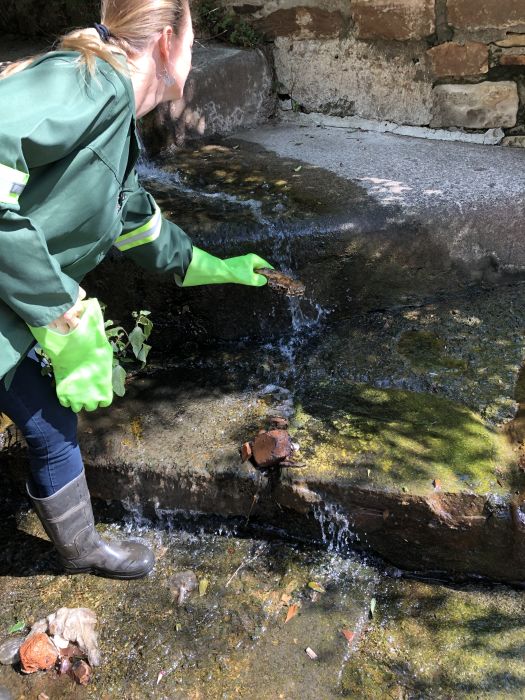







ジュクスケイ川は南アフリカのヨハネスブルグにある最大の川の一つです。この川は飲料水源であると同時に、地域の子供たちが水浴びしたり遊んだりする自然の空間でもあります。残念ながら、老朽化したインフラ、メンテナンス修理の遅れ、地元の廃棄物処理により、この川は深刻な下水汚染(未処理の下水と大腸菌の濃度が高い)に悩まされています。これまで、この川は手入れの行き届かない川として無視されてきましたが、2 人の先駆的な女性が川の一部を清潔にしようと取り組んでいます。
環境保護活動家のロミー・スタンダー氏は、ヨハネスブルグは亜大陸の汚染源でもあると指摘しました。ユクスケイ川が市内の汚染物質を北のクロコダイル川、ハートビースポート・ダム、リンポポ川に運んでいます。意欲的な住民や支援団体は、川の汚染は致命的なものではなく、地域全体の取り組みによって川はかつての清潔さを取り戻せると確信しています。
スタンダー氏とアーティストのハンネリー・クッツェー氏は、研究、緑のインフラ、アートを活用して水質汚染に取り組むことに尽力しており、そのモデルが全国の他の川にも応用されることを望んでいます。地元コミュニティと緊密に協力しながら、2人は2020年12月に外来侵入植物を除去する取り組みを開始し、川を守るために天然の水フィルターを建設する計画を進めています。
「水は社会を反映するもので、今回の水は有毒です」と、クッツェー氏とともに慈善団体「ウォーター・フォー・ザ・フューチャー」を共同設立したスタンダー氏は言います。「私たちは、安全な水と、人々とコミュニケーションできるエコアートで満たされた緑の回廊を作りたいのです」
ウォーター・フォー・ザ・フューチャーは、ヨハネスブルグ都心部の元洗濯工場であるビクトリア・ヤードに拠点を置いています。現在はアートスタジオ、コミュニティ野菜畑、診療所、託児所などが入居しており、すべてジュクスケイ川沿いに建てられています。
スタンダー氏とコーツェー氏は、エンジニア、研究者、建築家、科学者とともに、川を恒久的に修復するために何ができるかを理解しようとしている。2020年9月、Campbell Scientific社とSRKコンサルティング社は、川の水質と流出量を計測するために監視ステーションと水質サンプリング装置を設置した。研究により、ウォーター・フォー・ザ・フューチャーは、違法な下水道接続、崩壊した雨水排水路、市内の急速な都市化が川に圧力をかけている影響を理解することができた。
監視ステーションから収集されたデータは、以下の目的で使用されます。
- ビクトリアヤードの訪問者と住民を教育する
- 大学の学生プロジェクトを通じて異常気象への対応と都市排水を予測する
- ヨハネスブルグ市のジュクスケイ川プロジェクトに貢献する
- ビクトリアヤードの川沿いの生態系の再生と強化の取り組みにおいて、集水域内の修復とジュクスケイ川の水の利用を目標に、ジュクスケイ川の流れと水質フラックスのメカニズムの理解を深める
- 多くの都市研究に役立つ排出と水質反応記録を作成する
監視システムの構築には以下の機器が使用されました。
- CR300
- CELL215
- CS475
- HygroVUE™5
- TR-525 (Texas Instruments 社製)
ビクトリア ヤードのユクスケイ川上流の流量と水質を監視するために、統合水質サンプリング装置が設置されました。これにより、流量定格サンプリングが可能になり、流量が低いときに 1 つのサンプルが自動的に抽出されます。その後、降雨時に流量が増加すると、サンプルはより頻繁に自動的に採取されます。これにより、特に降雨イベントの対応時に、流量と水質の同時記録が得られます。
これらのパラメータを、関連する水の安定同位体とともに調べることで、Water for the Future は、排出物と水質物質の発生源と経路を推測することができます。これは、次のように修復措置を評価するための重要な第一歩です。
- 水質濃度(流量の時系列とともに)を知ることで質量負荷を計算することができます。これはピーク濃度よりも重要であることが多いです。
- 同様の排出率での質量負荷の季節変動を評価する
- 雨水管網の変更や修復措置の実施による即時的な影響を評価する
- 降雨流出雨水モデルの較正を可能にする気象測定の収集
収集されたデータは、関心のあるすべての関係者に公開されることが意図されており、ヨハネスブルグ市の監視ネットワーク、研究およびコンサルティング活動、および Water for the Future の修復計画と特定の水利用プロジェクトに貢献することが含まれます。
ケーススタディの概要
アプリケーション
水質の監視場所
ヨハネスブルグ、南アフリカ使用製品
HygroVue 5 CELL215 CS475-L CR300寄稿者
Campbell Scientific Africa (CSAF)参加団体
ヨハネスブルグ市、 Water for the Future計測項目
水質、水位、水温、相対湿度PDFで見る